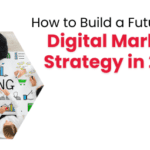
10 Steps to Craft an Effective Content Marketing Strategy
Content marketing has evolved into an effective marketing tool. It helps businesses connect with the audience, build brand awareness, and drive engagement. A well-crafted content marketing strategy is essential for achieving these goals effectively. Whether you are launching a new campaign or optimizing the existing one, these 10 steps will guide you to craft a robust content marketing strategy that will deliver measurable results.
1. Define Your Goals
Every successful content marketing strategy starts with setting clear, actionable goals. Define what you want to achieve with your content marketing strategy. Do you want to improve brand visibility or generate leads? Are you looking to boost customer retention or enhance sales?
Set your SMART goals: Specific, Measurable, Achievable, Relevant, and Time-bound. These goals provide directions and focus for your strategy. For instance, if looking to generate leads, you can set a specific numeric goal, such as 500 new leads in the coming six months, using content-driven lead magnets.
2. Understand Your Audience
Understanding your audience helps you create content that resonates. Start by building detailed buyer personas that represent your ideal customers. This should include details like demographic information, interests, pain points, and content consumption habits.
Conduct some research to understand your audience through surveys, interviews, and social media insights. Analyze this information to identify your target audience’s needs and preferences. This will ensure that your content addresses their challenges and interests.
3. Conduct a Content Audit
Prior to embarking on crafting fresh content, evaluate your existing content. Conduct a detailed content audit to evaluate the performance of your existing assets. Identify the content pieces that performed well and the ones that haven’t. Identify any gaps in the content.
Look for patterns in what appeals to your audience and what doesn’t. This audit will help you understand what’s working, what requires improvement, and how to align your new content with your marketing strategy.
4. Develop Your Content Plan
Now that you have understanding of your audience, it’s time to now develop a detailed content strategy. Identify what kind of content will suit your audience’s requirements—maybe it’s blogs, videos, infographics, podcasts, or updates on social media.
Create a content calendar highlighting important dates, themes, and topics to ensure consistent and timely delivery. Plan your content distribution and promotion channel to maximize reach and engagement. For example, you’re launching a new product, schedule blog posts, social media posts, and email campaigns, all coordinated with the product’s launch.
5. Craft Engaging Content
The heart of your content marketing strategy lies in the content. Prioritize creating high-quality, engaging content that delivers value to your audience. Use storytelling approach to make your content relatable and memorable.
Make sure all content is optimized for SEO, using relevant keywords organically to boost visibility in search engines. No matter the medium – an engaging blog post, an informative video, or a visually appealing infographic – your content should be crafted to captivate and inform.
6. Implement a Distribution Strategy
Creating good content is just the beginning; its effective distribution is key to success. Choose the best channels to distribute your content based on where your audience engages most. Such channels may include social media, email newsletters, industry forums, or partnerships with influencers.
Tailor your context for each platform to optimize engagement. For instance, a detailed blog post can be summarized into bite-sized and easy-to-read social media posts or infographics for broader reach. Consider using paid advertising to increase visibility and reach a larger audience if necessary.
7. Measure and Analyze Performance
Tracking the performance of your content is essential to understanding its impact and effectiveness. Identify key performance indicators (KPIs) that align with your goals, like website traffic, social media engagement, lead conversion, and content shares.
Use analytics tools to gather data and insights on your content’s performance. Analyze this data to determine what’s working well and what needs improvement. Regularly reviewing these performance metrics enables you to refine your strategy and make informed decisions.
8. Optimize and Iterate
Content marketing is not a one-time effort but an ongoing process. Learn from how well your content performs and iterate your content strategy. Experiment with different content formats, distribution channels, and promotional tactics to see what works best.
Stay updated with industry trends and audience feedback to keep your content fresh and relevant. Regularly test and refine your approach to ensure your content marketing efforts remain effective and aligned with your goals.
9. Foster Team Collaboration
An effective content marketing strategy often involves multiple stakeholders. These can be content creators, designers, marketers, and strategists. Establish clear roles and responsibilities to ensure smooth execution. Encourage good communication and collaboration to foster creativity and efficiency.
Train your team regularly and provide support so they stay up-to-date with the latest content marketing practices and tools. A well-coordinated team is important for a cohesive and effective content marketing strategy.
10. Evaluate Content Marketing Services
For businesses that may not have the resources and expertise to handle in-house content marketing teams. These businesses can consider outsourcing their content marketing services. These professional services bring expertise in building and executing content strategies, generating high-quality content, and managing distribution.
Evaluate potential content marketing services providers based on their past success, expertise, and ability to align with your goals. A reliable provider can assist in streamlining your content marketing efforts and achieving your objectives more efficiently.
Conclusion
An effective content marketing strategy isn’t just about creating content. It’s about developing an integrated plan that aligns with your business objectives and connects with your audience. Prioritizing quality, choosing the right distribution channels, and constantly enhancing your strategy can lead to a plan that captivates your audience and delivers meaningful outcomes for your business. Whether you’re handling your plan in-house or working with a content marketing service provider, success lies in consistent efforts, creativity, and a deep understanding of your audience’s needs.










